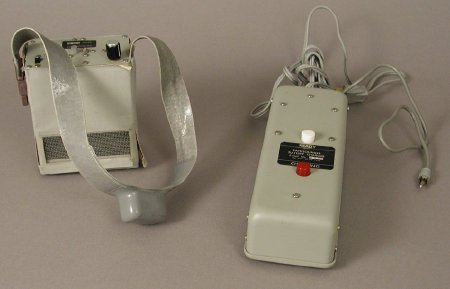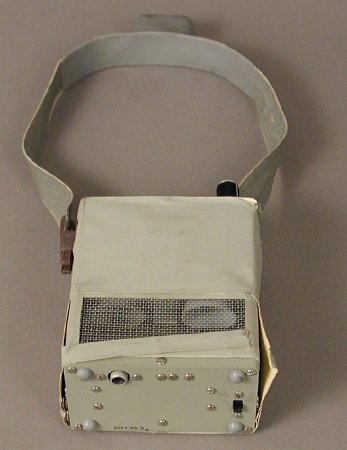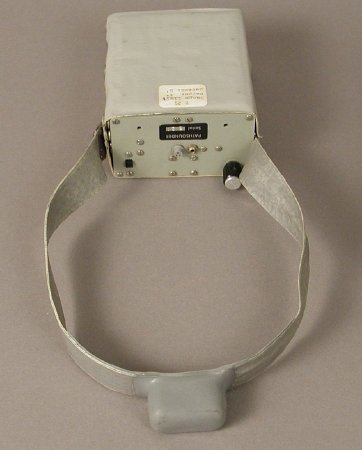Object ID:
2007.33.3
Title:
Russell Pathsounder, E-Model
Description:
(a) Battery charger, rectangular gray plastic box, with gray rubber power cord and connector cable with RCA jack; black foil adhesive label on top between white and red lights, "PATHSOUNDER/ BATTERY CHARGER/ SERIAL No. 26/120 Volt 50-60 Cycle"; red light indicates charging, white is ready; four black rubber feet on base; (b) E-Model Pathsounder; rectangular aluminum case, gray linen tape wrapping on four sides secured with snaps which are riveted to case; screen windo on lower front forms the ultrasonic detector window; bottom has four gray rubber feet, the charging jack and a slider on/off switch; top of case features two speaker holes, test jack, telemetry jack, vibration on/off switch, and rotary volume control; gray rubberized linen neck loop snaps into a red rubber clasp on one side; rounded gray rubber housing for the neck vibrator is in the middle of the neck loop; foil tag on top, "PATHSOUNDER/SERIAL No. E21"; adhesive tag on side, "E 21/Range Limit/ Beeps 4'/Buzzes 8'".
Dimensions:
H-13.25 W-7 D-2.5 inches
Date:
1974
Place of Origin:
Massachusetts Institution of Technology
Provenance:
This unit was donated to the AER Bledsoe Archives at the Maryland School for the Blind by the Rehabilitation Research and Development Services Division of the Veterans Administration in 1989. The Pathsounder was invented by Lindsay Russell while working with the Sensory Aids Evaluation and Development Center at MIT. The first model to be field tested was Model H in 1968-69. By 1974, the E model was being made for distribution at the three VA Blind Rehabilitation Centers. Worn around the neck, it was designed as a secondary electronic travel aid (ETA), in addition to the use of the long cane. Emitting a sound(buzzing or beeping), or a vibration (at the chest or neck), or both, it alerted the user to objects within the field of view above and below the waist, in the direct travel path, within a distance of 6-8'. It was never produced in numbers beyond those needed for experimental purposes.
Credit Line:
Gift of Association for Education and Rehabilitation of the Blind and Visually Impaired


